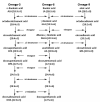The essentiality of arachidonic acid and docosahexaenoic acid
- PMID: 19540099
- PMCID: PMC3361712
- DOI: 10.1016/j.plefa.2009.05.020
The essentiality of arachidonic acid and docosahexaenoic acid
Abstract
Objective: The purpose of this review is to correlate the clinical finding that patients receiving parenteral nutrition with a fish oil-based lipid emulsion do not develop essential fatty acid deficiency (EFAD) with an experimental murine model, thus showing that arachidonic acid (AA) and docosahexaenoic acid (DHA) are likely to be the essential fatty acids.
Background: Conventional belief is that linoleic acid (LA, omega-6) and alpha-linolenic acid (ALA, omega-3) are the essential fatty acids (EFAs). We have shown that a fish oil-based lipid emulsion containing AA (omega-6) and docosahexaenoic acid (omega-3) and insignificant quantities of LA and ALA is efficacious in the treatment of parenteral nutrition-associated liver disease (PNALD), a major cause of liver-related morbidity and mortality. The prospect of using a fish oil-based lipid emulsion as monotherapy has raised concerns of EFAD development, hindering its adoption into clinical practice.
Design: Data from patients in our institution who received PN with a fish oil-based lipid emulsion was reviewed for clinical and biochemical evidence of EFAD, defined as an elevated triene-tetraene ratio (Mead acid/AA>0.2). We also investigated the minimum amount of fish oil required to prevent EFAD in a murine model and determined whether DHA and AA alone can prevent EFAD.
Results: No patients receiving PN with a fish oil-based lipid emulsion in our institution have developed biochemical or clinical evidence of EFAD such as an elevated triene-tetraene ratio, growth retardation or dermatitis. This observation parallels our previously published animal studies, which demonstrated prevention of EFAD when 13% of total calories were from fish oil. Moreover, current work in our laboratory shows that AA and DHA provision alone is sufficient to prevent biochemical and physiologic evidence of EFAD in a murine model.
Conclusions: When dosed appropriately, fish oil-based lipid emulsions contain sufficient EFAs to prevent EFAD. Furthermore, AA and DHA alone may be the true EFAs.
Figures
References
-
- Voet DV, JG . Biochemistry. 3rd ed J. Wiley & Sons; New York: 2004.
-
- Das UN. Essential fatty acids: biochemistry, physiology and pathology. Biotechnol J. 2006;1:420–39. - PubMed
-
- Burr GO, Burr MM. Nutrition classics from The Journal of Biological Chemistry 82:345-67, 1929. A new deficiency disease produced by the rigid exclusion of fat from the diet. Nutr Rev. 1973;31:248–9. - PubMed
-
- Burr GO, Burr MM. On the nature and role of the fatty acids essential in nutrition. The Journal of Biological Chemistry. 1930;86
-
- Burr GO, Burr MM, Miller ES. On the fatty acids essential in nutrition. III. The Journal of Biological Chemistry. 1932;97:9.
Publication types
MeSH terms
Substances
Grants and funding
LinkOut - more resources
Full Text Sources
Other Literature Sources
Molecular Biology Databases



